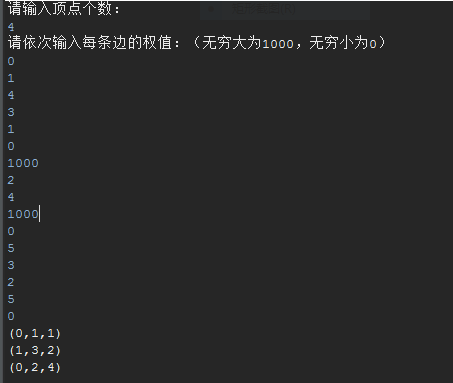鄰接矩陣儲存圖Java實現
阿新 • • 發佈:2019-01-06
import java.util.Scanner; /** * 鄰接矩陣儲存的圖 * @author liangxiamoyi * */ public class Graph_Matrix { /** * 圖中最大頂點個數 */ public static int MAXGRAPHSIZE=256; /** * 圖中最大權值 */ public static int MAXWEIGHT=1000; /** * 鄰接矩陣 */ private int[][] edge; /** * 當前圖中頂點個數 */ private int graphSize; /** * 構造方法 */ public Graph_Matrix(){ this.edge=new int[MAXGRAPHSIZE][MAXGRAPHSIZE]; System.out.println("請輸入頂點個數:"); Scanner sc=new Scanner(System.in); this.graphSize=sc.nextInt(); System.out.println("請依次輸入每條邊的權值:(無窮大為1000,無窮小為0)"); for(int i=0;i<this.graphSize;i++){ for(int j=0;j<this.graphSize;j++){ this.edge[i][j]=sc.nextInt(); } } } /** * 取得序號為v的頂點的第一個鄰接頂點的序號 * @param v 序號v * @return 第一個鄰接頂點的序號 */ public int getFirstNeighbor(int v){ if(v==-1)return -1; for(int i=0;i<this.graphSize;i++){ if(this.edge[v][i]>0&&this.edge[v][i]<MAXWEIGHT){ return i; } } return -1; } /** * 取得v1頂點相對於v2頂點的下一個鄰接頂點 * @param v1 頂點v1 * @param v2 頂點v2 * @return 下一個鄰接頂點的序號 */ public int getNextNeighbor(int v1,int v2){ if(v1==-1||v2==-1){ return -1; } for(int i=v2+1;i<this.graphSize;i++){ if(this.edge[v1][i]>0&&this.edge[v1][i]<MAXWEIGHT){ return i; } } return -1; } /** * 插入一個頂點 */ public void insertVertex(){ for(int i=0;i<this.graphSize;i++){ this.edge[i][graphSize]=MAXWEIGHT; } for(int i=0;i<this.graphSize;i++){ this.edge[graphSize][i]=MAXWEIGHT; } this.edge[graphSize][graphSize]=0; this.graphSize++; System.out.println("插入成功!"); return ; } /** * 刪除 一個頂點 * @param v 刪除的頂點 */ public void deleteVertex(int v){ if(v>=this.graphSize){ System.out.println("無此頂點"); return; } for(int i=0;i<this.graphSize;i++){ this.edge[v][i]=0; this.edge[i][v]=0; } if(v==this.graphSize-1){ this.graphSize--; return; } for(int i=v+1;i<this.graphSize;i++){ for(int j=0;j<this.graphSize;j++){ this.edge[i-1][j]=this.edge[i][j]; } } this.graphSize--; } /** * 插入一條邊 * @param v1 起點 * @param v2 終點 * @param weight 權值 */ public void insertEdge(int v1,int v2,int weight){ if(v1==v2||v1>this.graphSize||v2>this.graphSize||this.edge[v1][v2]!=MAXWEIGHT){ System.out.println("插入失敗!"); return; } this.edge[v1][v2]=weight; System.out.println("插入成功!"); return; } /** * 刪除一條邊 * @param v1 起點 * @param v2 終點 */ public void deleteEdge(int v1,int v2){ if(v1==v2||v1>this.graphSize||v2>this.graphSize||this.edge[v1][v2]==MAXWEIGHT){ System.out.println("刪除失敗!"); return; } this.edge[v1][v2]=MAXWEIGHT; System.out.println("刪除成功"); return; } /** * 求圖中任意兩點的最短路徑 */ public void allLengths(){ int n=this.graphSize; int[][] path=new int[n][n];//相應路徑上頂點j的前一個頂點 int[][] a=new int[n][n];//兩點最短路徑長度 for(int i=0;i<n;i++){ for(int j=0;j<n;j++){ a[i][j]=edge[i][j]; if(i!=j&&a[i][j]<MAXGRAPHSIZE)path[i][j]=i; else path[i][j]=-1; } } for(int k=0;k<n;k++){ for(int i=0;i<n;i++){ if(i!=k){ for(int j=0;j<n;j++){ if(j!=k&&j!=i&&a[i][k]<MAXGRAPHSIZE&&a[k][j]<MAXGRAPHSIZE&&a[i][k]+a[k][j]<a[i][j]){ a[i][j]=a[i][k]+a[k][j]; path[i][j]=path[k][j]; } } } } } //輸出 for(int i=0;i<n;i++){ for(int j=0;j<n;j++){ if(i!=j&&a[j][i]<MAXGRAPHSIZE){ System.out.println("頂點"+j+"到"+"頂點"+i+"的最短路徑長度:"+a[j][i]); System.out.print("最短路徑為:"+j); int k=j; while(path[i][k]!=i){ System.out.print(" "+path[i][k]); k=path[i][k]; } System.out.print(" "+i); } } } } /** * 對無向加權連通圖,求最小支撐樹的prim演算法 */ public void prim(){ int n=this.graphSize; //權值最小的邊類 class LV{ int lowCost;//權值 int vex;//邊的終點 } LV[] closeEdge=new LV[n]; //支撐樹的邊類 class Edge{ int head;//頭 int tail;//尾 int cost;//權值 } Edge[] te=new Edge[n-1]; for(int i=0;i<n;i++){ for(int j=0;j<n;j++){ if(edge[i][j]==0)edge[i][j]=MAXWEIGHT; } } //以頂點0為初始頂點,初始化陣列closeEdge for(int i=0;i<n;i++){ closeEdge[i]=new LV(); closeEdge[i].lowCost=edge[0][i]; closeEdge[i].vex=0; } closeEdge[0].vex=-1;//頂點0進入集合 int count=0;//支撐樹的邊數 for(int i=0;i<n;i++){ int min=MAXWEIGHT+1; int v=0; for(int j=0;j<n;j++){//求當前權值最小的邊和該邊的終點v if(closeEdge[j].vex!=-1&&closeEdge[j].lowCost<min){ v=j; min=closeEdge[j].lowCost; } } //向支撐樹的邊集合中新增一條邊 if(v!=0){ te[count]=new Edge(); te[count].head=closeEdge[v].vex; te[count].tail=v; te[count].cost=closeEdge[v].lowCost; count++; //頂點v進入集合U closeEdge[v].lowCost=0;//修改域值 closeEdge[v].vex=-1; for(int j=0;j<n;j++){ if(closeEdge[j].vex!=-1&&edge[v][j]<closeEdge[j].lowCost){ closeEdge[j].lowCost=edge[v][j]; closeEdge[j].vex=v; } } } } for(int i=0;i<n-1;i++){ System.out.println("("+te[i].head+","+te[i].tail+","+te[i].cost+")"); } } //測試 public static void main(String[] args){ // 測試資料 // 0 // 2 // 7 // 1000 // 1 // 1000 // 0 // 1000 // 1000 // 1000 // 1000 // 1000 // 0 // 5 // 1000 // 1000 // 1000 // 1000 // 0 // 1000 // 3 // 1000 // 1000 // 4 // 0 Graph_Matrix gm=new Graph_Matrix(); System.out.println(gm.getFirstNeighbor(0)); System.out.println(gm.getNextNeighbor(0, 1)); gm.insertVertex(); gm.insertEdge(5, 0, 2); gm.insertEdge(5, 1, 2); gm.insertEdge(5, 4, 2); System.out.println(gm.getFirstNeighbor(5)); System.out.println(gm.getNextNeighbor(5, 0)); gm.deleteEdge(5, 1); System.out.println(gm.getFirstNeighbor(5)); System.out.println(gm.getNextNeighbor(5, 0)); gm.deleteVertex(5); System.out.println(gm.getFirstNeighbor(5)); // 測試資料 // 0 // 1 // 4 // 3 // 1 // 0 // 1000 // 2 // 4 // 1000 // 0 // 5 // 3 // 2 // 5 // 0 Graph_Matrix g=new Graph_Matrix(); System.out.println("最小支撐樹為:"); g.prim(); } }
測試結果:


